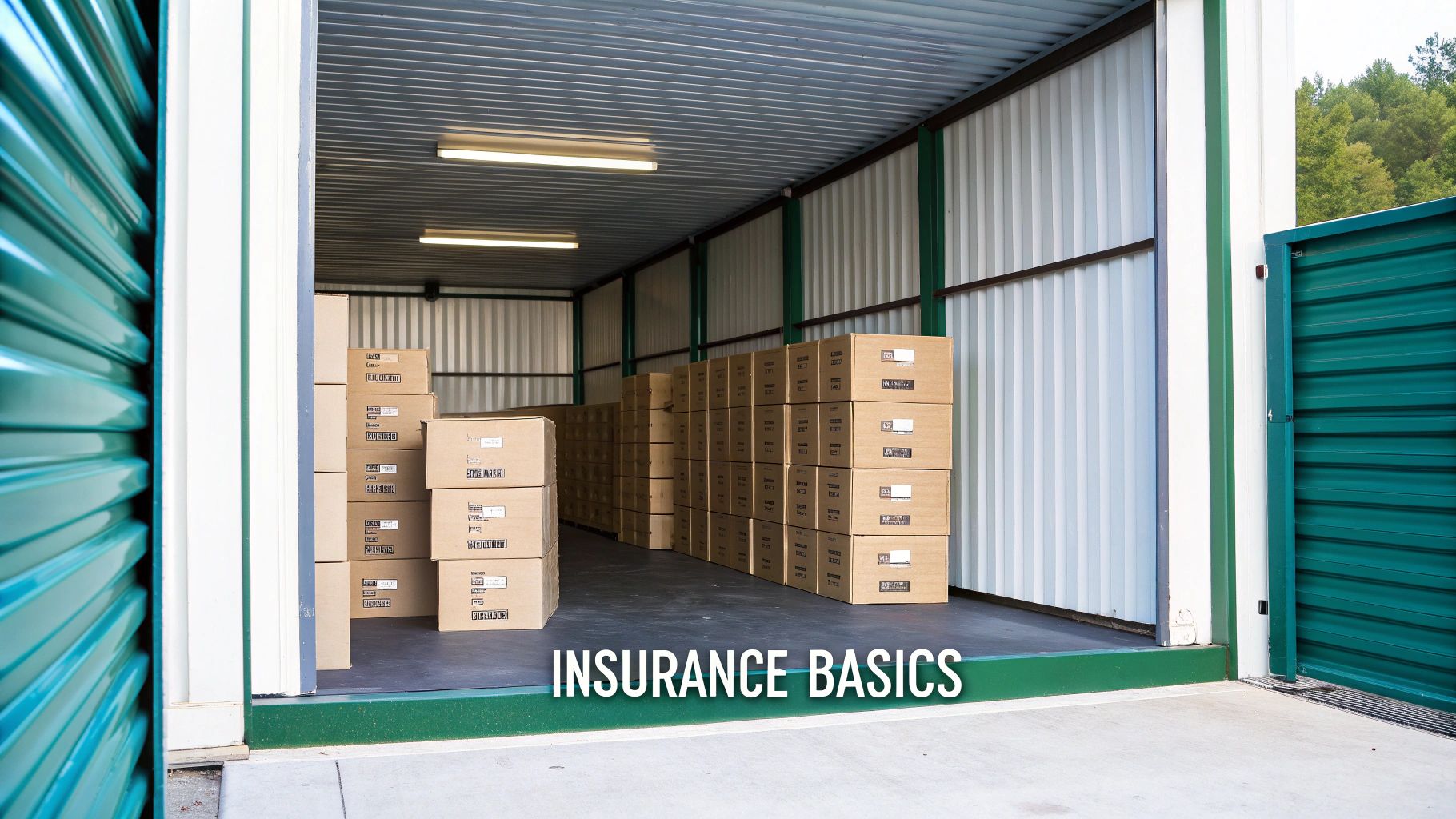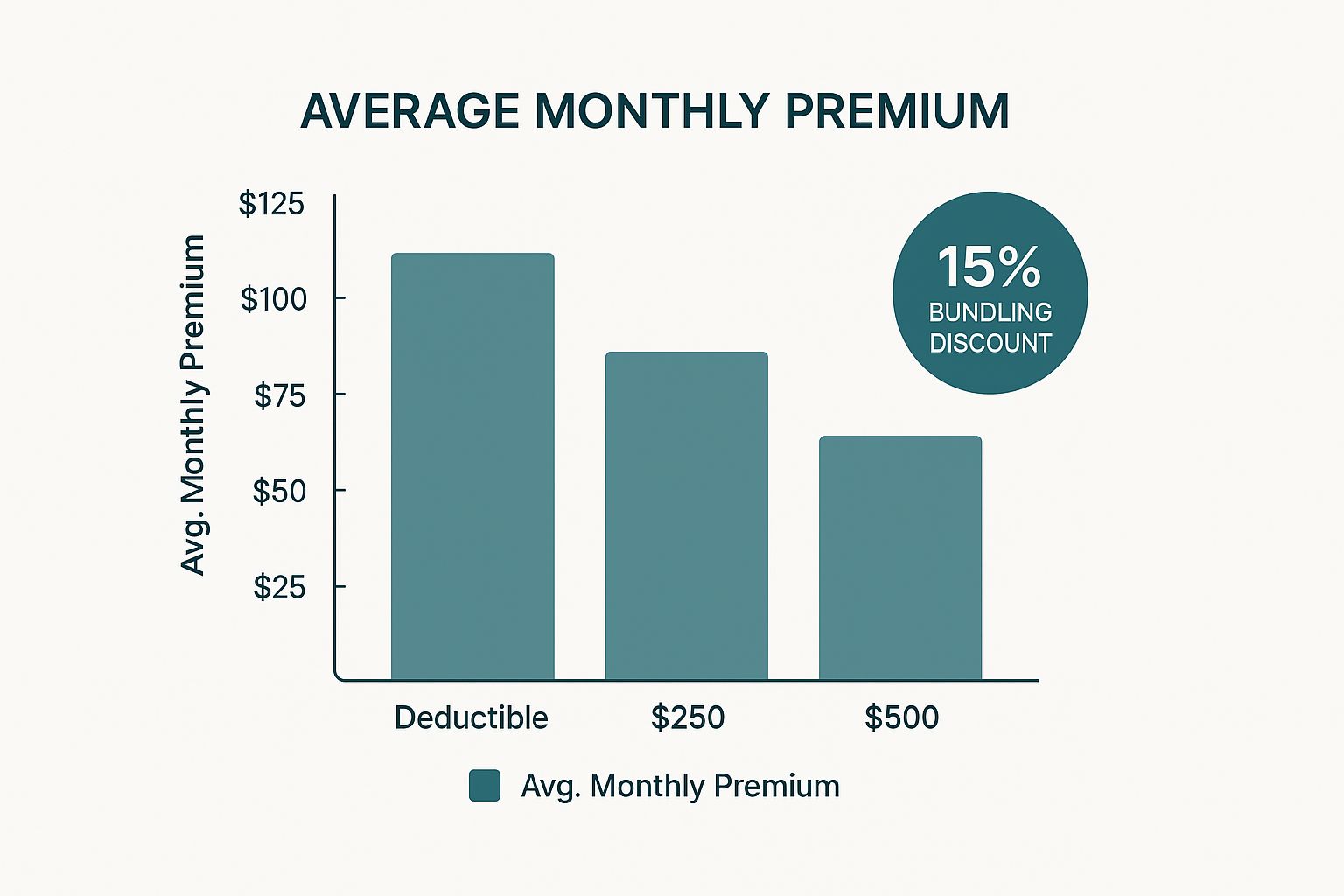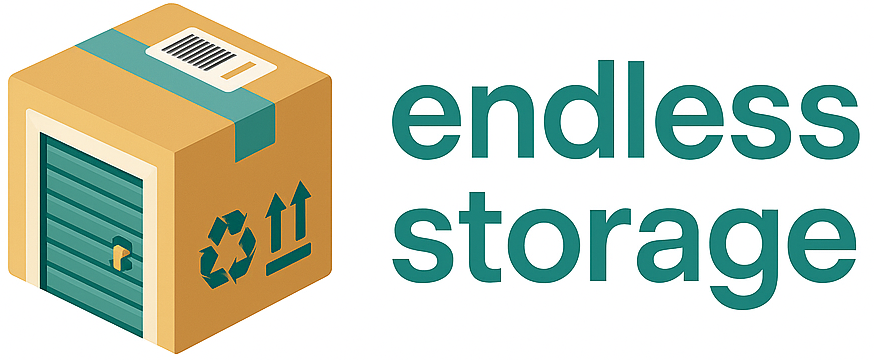When you start looking into self-storage, one of the first questions that pops up is, "What's this going to cost me?" While the monthly unit rental is the main event, insurance is a critical, often overlooked, part of the equation. So, what’s the real story on self storage insurance cost?
On average, you can expect to pay anywhere from $10 to $30 per month for a solid policy. Think of it less like a fixed price and more like a dimmer switch—the cost slides up or down based on how much stuff you’re protecting.
What Is The Average Self Storage Insurance Cost?

Protecting what you store is non-negotiable. The monthly premium for your policy is tied directly to the value of what's inside your unit. It just makes sense, right? You wouldn't insure a few boxes of old college textbooks for the same amount as a collection of rare vinyl records, and insurance providers get that.
Looking at the bigger picture, the annual cost for a standard self-storage policy in North America typically falls between $100 and $350. This range reflects the massive variety in what people store and the associated risks. Considering North America makes up about 41% of the entire global self-storage market, it's clear that millions of people rely on this kind of protection.
The bottom line is simple: the more your stuff is worth, the more coverage you'll need, which means a slightly higher premium. The goal is to find that sweet spot where you’re fully covered without paying for more than you need.
To help you get a better feel for it, let's look at some real numbers.
Estimated Monthly Self Storage Insurance Cost by Coverage Amount
This table gives you a quick snapshot of what you might pay each month for self-storage insurance, depending on the total value of your items.
As you can see, doubling your coverage doesn't automatically double your premium. This makes getting the right amount of protection a lot more affordable than most people think.
For a deeper dive into how these costs are calculated and all the factors involved, be sure to read our complete guide on storage insurance cost. It'll give you everything you need to make a smart decision for your specific situation.
Key Factors That Drive Your Insurance Rate
Ever wondered why your insurance quote looks so different from a friend's? Self-storage insurance costs aren’t just pulled out of a hat. They’re carefully calculated based on a few key ingredients, much like baking a cake—what you get out depends entirely on what you put in.
The biggest piece of the puzzle is, without a doubt, the total value of the items you're storing. This is the bedrock of your policy. If you’re just stashing a few boxes of holiday decorations worth maybe $1,000, your premium will be a drop in the bucket compared to someone storing $15,000 worth of furniture, electronics, and priceless family heirlooms. Insurers have to base your rate on their potential payout, so a higher value means a higher rate. Simple as that.
But the value of your stuff is just the starting line. A handful of other factors also play a major role in shaping your final premium.
Your Geographic Location Matters
Where your storage unit lives has a direct line to your insurance rate. Insurers use your zip code to get a read on local risks, especially the chances of natural disasters striking. A unit in a coastal town prone to hurricanes will naturally come with a higher premium than one tucked away in a region with a mild, stable climate.
It’s not just about weather, either. Areas with higher rates of theft or vandalism will also see costs tick upward. The logic is pretty straightforward: higher risk for the insurance company translates to a higher self-storage insurance cost for you.
You can think of it as a game of probability. The greater the chance of something like a fire, flood, or break-in happening in a specific area, the more the insurer has to charge to cover that potential risk.
The Quality of the Storage Facility
Not all storage facilities are built the same, and you can bet insurers pay close attention to the differences. The security features and even the construction materials of your chosen facility can either help or hurt your premium. A modern, well-kept facility is just seen as a much safer bet.
Here are a few key features that can actually lead to lower insurance rates:
- Advanced Security Systems: Places with 24/7 camera surveillance, electronic gate access, and on-site managers are a major deterrent for thieves.
- Fire Suppression and Safety: Sprinkler systems, smoke detectors, and buildings made with fire-resistant materials dramatically reduce the risk of a total loss.
- Climate-Controlled Units: While you might get one to protect your sensitive items, these units are often housed in better-constructed buildings, which lowers the overall risk. If you are storing delicate items, understanding the benefits of self-storage climate control is a must.
Beyond what your items are worth, the level of protection offered by your storage provider is a huge factor. Checking out what secure self storage facilities offer can give you a good idea of what to look for. Choosing a top-notch facility with serious security is one of the smartest, most proactive steps you can take to keep your insurance costs in check.
Understanding What Your Policy Actually Covers

It’s an easy mistake to make—assuming your storage insurance is a bulletproof safety net for anything and everything that could go wrong. In reality, it’s much more specific. Think of your policy less like a force field and more like a targeted security system designed to guard against certain threats, but not others. It's built to handle common disasters, but it definitely has its limits.
A standard policy isn’t just a piece of paper; it’s your financial backup when disaster strikes. Getting a handle on these boundaries right from the start is the best way to avoid nasty surprises if you ever have to file a claim. It ensures you’re actually protecting what you value most.
What Your Policy Typically Includes
Most self-storage insurance policies are designed to cover the big, sudden, and accidental events that can cause major damage. They’re built to give you peace of mind against the most common risks that come with storing your belongings away from home.
These policies generally protect your stuff from:
- Fire and Smoke: Covers damage from fires that start either inside or outside your unit.
- Theft and Burglary: Protects you if someone breaks into your unit and steals your items (you'll need a police report for this).
- Certain Water Damage: This usually covers damage from things like a burst pipe or a leaky roof, but almost never from natural floods.
- Building Collapse: If the storage facility's structure gives way and damages your property.
- Vandalism: Covers intentional damage or defacement of your belongings.
The key takeaway here is that these policies focus on "named perils." This means they only cover the specific events listed in the policy documents. If it’s not explicitly mentioned, it's probably not covered. That’s why reading the fine print is so critical.
Common Exclusions You Must Know
Just as important as what’s covered is what isn’t. Every insurance policy has exclusions, and this is exactly where people get tripped up. Overlooking these coverage gaps can turn into a very expensive mistake.
Common exclusions you’ll almost always find include:
- Floods: Standard policies virtually never cover damage from natural flooding.
- Earthquakes: Protection from seismic events usually requires a separate policy or add-on.
- Mold and Mildew: Damage from slow-growing mold or mildew is typically excluded.
- Pest Infestations: Damage from rodents, insects, or other vermin is generally not covered.
- Valuable Documents and Data: Things like cash, stock certificates, and sensitive data are almost always excluded.
Beyond the basics, you also need to understand concepts like insurance policy limits, which cap the maximum amount the company will pay out for a claim. For a deeper dive into what you can and can't protect, check out our complete guide on insuring items in storage.
When it comes to protecting your stuff in storage, you've got choices. It’s not a one-size-fits-all situation. Think of it less like a single-lane road and more like a roundabout with a few different exits. Figuring out which path to take is the first step to getting the right protection without breaking the bank.
Basically, you have three main routes: going with the insurance plan the storage facility offers, checking if your current homeowners or renters policy has you covered, or finding a specialized policy from an independent company. Each one comes with its own set of pros and cons that affect both your wallet and your peace of mind.
Option 1: The Facility’s In-House Plan
Just about every storage facility will offer—and often require—you to buy their own insurance plan. This is hands-down the easiest option. You can usually sign up right at the counter when you're getting your unit, and they'll just tack the cost onto your monthly rent. Simple.
But that convenience can come with a catch. These plans, sometimes called "protection plans," can have higher monthly costs and more coverage gaps than other choices. They're built for simplicity, not necessarily for bulletproof protection, so you absolutely have to read the fine print before you sign on the dotted line.
Option 2: Your Homeowners or Renters Policy
There's a good chance your existing homeowners or renters insurance already provides some coverage for belongings stored outside your home. This is what's known in the industry as "off-premises coverage." Before you just assume you're good to go, though, you need to pick up the phone and call your insurance agent.
The biggest question to ask is about the coverage limit. Off-premises coverage is typically capped at just 10% of your total personal property coverage. So, if your policy covers $50,000 worth of stuff inside your house, you might only have $5,000 of coverage for everything in your storage unit. For many people, that's just not enough. You also need to ask specifically what events (they call them "perils"), like fire or theft, are covered when your items are in storage.
Option 3: Specialized Third-Party Insurance
The third route is to buy a policy from a company that lives and breathes self-storage insurance. Because this is all they do, they often provide more comprehensive plans at a better price than what you'd get from the facility. It's their specialty, so they're built to cover a wider range of potential disasters.
For most people, a third-party policy will run somewhere between $10 to $30 per month, depending on how much coverage you need. The exact price will shift based on where you live and what you're storing, of course.
The infographic below shows how your premium can change based on the deductible you select.

As you can see, choosing a higher deductible is a direct way to lower your monthly payment, giving you more control over your budget. This kind of flexibility is a huge plus, especially if you're using temporary self storage and need to keep a close eye on your expenses.
To make things even clearer, let's break down these three choices side-by-side.
Comparing Your Self Storage Insurance Options
This table lays out the core differences between the three main ways to insure your stored items, helping you see which one is the best fit for your specific needs and budget.
Ultimately, the best choice depends on what you're storing and how much risk you're comfortable with. Weighing these options carefully will ensure your belongings are properly protected while they're away from home.
Practical Ways To Lower Your Insurance Premiums

Let's be honest, no one wants to spend more than they have to on insurance. The good news is that controlling your self-storage insurance cost is easier than you might think. With a few smart moves, you can lock in the protection you need without breaking the bank.
The very first step—and this is a big one—is to create a detailed inventory of everything you plan to put into storage. I know it sounds like a chore, but it’s a critical financial move. Without an accurate list and a solid estimate of what everything’s worth, you’re just guessing how much coverage to buy. That's a surefire way to pay for protection you'll never actually use.
Think of it like going grocery shopping for a specific recipe. If you don't bring a list, you're bound to come home with way too much cilantro and forget the main ingredient. Your inventory is your recipe for insurance, making sure you buy exactly the right amount of coverage.
Be Smart About Your Facility Choice
The storage facility you pick has a direct line to your insurance premium. It makes sense, right? Insurers are all about managing risk, so they absolutely love features that make your stuff safer—and they often reward you with lower rates for choosing a secure spot.
When you're facility hunting, keep an eye out for these premium-slashing features:
- 24/7 Video Surveillance: Nothing says "go away" to thieves like continuous camera monitoring.
- Electronic Gate Access: A coded entry system is a huge plus, as it ensures only authorized people can get onto the property.
- On-Site Management: Having a manager physically present during business hours adds a serious layer of security and oversight.
- Fire Protection: Facilities equipped with sprinkler systems and fire alarms are seen as much less risky by insurance carriers.
Picking a place with these safeguards signals to your insurer that your belongings are well-protected. Less risk for them means a lower bill for you.
Adjust Your Policy To Fit Your Budget
Once you know what you’re storing and where you’re storing it, you can start fine-tuning your policy to save even more. One of the most effective ways to do this is by choosing a higher deductible. The deductible is simply the amount you agree to pay out-of-pocket before your insurance coverage kicks in.
Key Insight: Opting for a higher deductible, like $500 instead of $100, can drop your monthly premium almost instantly. Just be sure it’s an amount you could comfortably cover if you ever needed to file a claim.
Finally, don't be shy about asking for discounts. Many insurance providers offer savings that aren't always plastered on their homepage. You might just qualify if you are:
- A student or university faculty member
- Active-duty military personnel or a veteran
- A renter planning to stay long-term
- Bundling your storage insurance with another policy (like renters or auto)
These little discounts can really add up over the life of your policy. If you're hunting for more ways to trim your budget, our guide on how to find cheap storage options has plenty of other useful tips. While every policy is different, you can also explore broader strategies to reduce your overall insurance expenditures to see how these cost-cutting ideas can apply elsewhere.
Got Questions About Self Storage Insurance? We've Got Answers.
When you're dealing with self-storage insurance, it’s easy to get tangled up in "what if" scenarios. Even after you think you've got the basics down, specific questions about your own stuff can pop up. This section is all about tackling those common questions with clear, straight-up answers so you can make decisions you feel good about.
Think of this as your personal FAQ for protecting your belongings. Let's clear up any confusion and get you that peace of mind you’re looking for.
Do I Have to Get Insurance for My Storage Unit?
While no state law is going to force you to buy it, you'll find that nearly every reputable storage facility makes it a non-negotiable part of the rental agreement. It's a smart policy that protects both you and the facility if the unexpected happens.
You typically have three ways to check this box:
- Buy the insurance plan offered directly by the storage facility.
- Show proof that your existing homeowners or renters policy covers your stored items.
- Purchase a separate, third-party policy that specializes in storage insurance.
Before you sign anything, always read the lease agreement closely. You need to know the facility’s specific rules and the minimum coverage amount they require.
Does My Homeowners Policy Cover Stored Items?
The short answer is: often, yes—but with some major strings attached. Most homeowners or renters insurance policies include something called “off-premises coverage,” which extends to personal belongings you store away from home.
Here's the catch: that coverage is usually capped at a pretty low amount, typically just 10% of your total personal property limit. So, if your policy covers $60,000 worth of stuff at home, you might only have $6,000 in protection for your storage unit. For a lot of people, that’s just not going to cut it. It also might not cover certain disasters, like water damage from a burst pipe in the facility.
Don't just assume you're covered. This is one of the most common and costly mistakes people make. Call your insurance agent and get the exact details on your off-premises coverage limits and what perils are included.
What Happens If I Am Underinsured?
Being underinsured is a gamble you don't want to take. If you are, and your belongings are destroyed in a fire or other covered event, the insurance company will only pay up to your policy's limit, minus your deductible. The rest of the loss is on you.
Imagine you have $15,000 worth of furniture and electronics stored away, but you only opted for a $5,000 policy to save a few bucks a month. If a fire wipes everything out, the absolute maximum you’ll get from the insurance company is $5,000. That leaves you with a $10,000 hole in your pocket.
This is exactly why taking an accurate inventory and choosing the right coverage amount is so critical. It’s about protecting yourself from a major financial hit.
Ready to store your belongings without the hassle of a traditional storage unit? With Endless Storage, you can store your items on a per-box basis, starting at just $7.99 per box. We provide free shipping kits, climate-controlled storage, and seamless 48-hour return shipping, all managed through your online account. Say goodbye to clutter and hello to convenience. Learn more about how Endless Storage works.
Frequently Asked Questions
Unveiling the Secrets to Effortless Storage
Endless Storage is available nationwide. You pick a plan, tell us where to pickup, and we'll send a UPS van to collect, whichever state you're in.
Your shipping label will be sent to your email within a few minutes, if not instantaneously. It can also be accessed through your customer profile.
Your box will be shipped to one of our climate controlled self storage facilities in our closest self storage facility. Our manager will accept your package, notify you that your box has been received, and securely stored. Only our managers will have access to Endless Storage boxes.
Email us at admin@endless-storage.com click to live chat with us, or send us a message below.
Never! We're committed to transparent pricing with no surprises. You'll lock in your rate with no hidden fees and no long-term contracts.
Fast access guaranteed! Your boxes will arrive at your doorstep within 48 hours of requesting them back. Need to check on delivery? We provide tracking information for complete peace of mind.
Totally flexible! Store month-to-month with no long-term commitment and cancel anytime.
Everything's online! Use your account dashboard to:
• Set up automatic monthly payments
• Request box returns
• Update your address
• Order additional boxes
• Track shipments
Your boxes are insured up to $100 each. Our customer service team will help you file any necessary claims and resolve issues quickly.
Don't worry – we'll email you right away if there's a payment issue. Your items stay safe, though you may have temporary service interruption or late fees until payment is resolved.
When you request our free storage kits, you'll have 30 days to send in your boxes to activate your 3 months of free storage. Think of it like starting a gym membership – your activation window begins when you receive your kits, and your full free trial begins once you send in your first box. During your free months, you'll experience our complete storage service at no cost.
Your 30-day activation window begins when you receive your storage kits. We'll send you an email confirmation when your kits are delivered, marking the start of your activation period.
If you haven't sent any boxes for storage within your 30-day activation window, your free trial will expire and we'll begin charging the regular monthly rate of $9.99 per box. This helps ensure our storage kits go to customers who are ready to use our service.
A box costs $9.99 per month to store (plus sales tax). This price includes free shipping for standard boxes under 50 lbs. and smaller than 16"x16"x16"
Log into your Endless Storage account, locate the box you would like returned, and simply click Return My Box.
Yes, each box stored with us is insured for up to $100 throughout transit as well as the duration of storage within our facilities.
Your box will be at your doorstep within 48 hours of you requesting it back.
Store 10+ boxes? We'll pick them up for free! After your purchase, we'll contact you to schedule a convenient pickup time and arrange UPS collection.
We trust UPS with all shipments, and every box includes $100 insurance coverage. You'll receive tracking information to monitor your items' journey.
Yes! Visit any of our locations by appointment. Just bring a photo ID matching your customer profile.
For everyone's safety, we can't store hazardous materials, firearms, or perishables. All items must fit within our standard boxes.
It's easy! Order your storage kit online, and we'll ship it to you within 1-2 business days. Your shipping labels will be emailed instantly and available in your account.
We're here to help! Email us at admin@endless-storage.com, use our live chat, or send us a message through your account.
To cancel your storage service with Endless Storage, please email your cancellation request to admin@endless-storage.com. Our team will process your request within 2 business days and confirm your cancellation via email.
We understand packing takes time. However, to maintain your free trial benefits, you'll need to send at least one box within the 30-day activation window. If you need more time, you can always start with one box to activate your trial and send the rest later. You can always reach out to admin@endless-storage.com if you have any issues or concerns.
When you request our free storage kits, you're starting a 30-day window to begin using our storage service.
To avoid any charges, simply send at least one box for storage within 30 days to activate your 3-month free trial. If you decide not to use our service and don't send any boxes within the 30-day window, a one-time $50 fee will apply to cover the costs of materials and shipping. This helps ensure our storage kits go to customers who are ready to use our service.
Think of it like reserving a hotel room – we're setting aside space and sending specialized packing materials for your use. The fee only applies if you request materials but don't begin storage, similar to a hotel's no-show charge.

